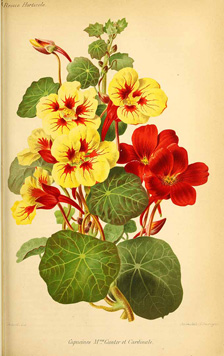Nationalistic Nasturtium
By Audrey Stallsmith

There was just a murmur of bees going in and out the brilliant little pouches of nasturtium flowers. The nasturtium leaf coins stood cool and grey; in their delicate shade, underneath in the green twilight, a few flowers shone their submerged gold and scarlet.
D. H. Lawrence, The Trespasser
Strangely enough, the garden plant commonly known as nasturtium doesn’t belong to the genus which bears that name. Nasturtium officinalis is the official designation for watercress, which has small white flowers.
About the only thing it shares with the uncapitalized and more brilliantly colored garden bloomer is peppery flavor. Nasturtium, in fact, means nose-twister, in reference to a person’s natural reaction to that "pepper."
The garden variety belongs to the genus Tropaeolum and derives its name from the trophy pile of their enemies’ helmets and shields often erected by Roman soldiers after a battle. The flowers of the plant are thought to resemble the blood-stained helmets and the round leaves the shields. That probably explains why the nasturtium stands for “patriotism” in the Language of Flowers.
It originated in Central and South America, with the minus variety being brought to Spain by botanist Nicolas Monardes as early as 1569. At the time, nasturtiums often were called “Indian cresses.” Our current most common annual types combine the qualities of Tropaeolums majus, minus, and peltophorum, and usually come in warm colors such as yellows, oranges, and reds.
The leaves once were thought to be somewhat phosphorescent. In his 1854 book, The Poetry of Science, Robert Hunt noted that "If a nasturtium is plucked during sunshine, and carried into a dark room, the eye, after it has reposed for a short time, will discover the flower by a light emitted from its leaves." I'll have to try it sometime!
For those of you who turn up your noses at common and easy-to-grow garden flowers, there are more exotic tuberous tropaeolums which present much more of a challenge. I recall that I did succeed in germinating the blue nasturtium (Tropaeolum azureum) once. It didn’t last long, though. Looking back now, I suspect the plant probably just went dormant and a less experienced me assumed it was dead!
Gardeners who prefer the unusual also may want to opt for speciosum with red flowers or tricolor with red, purple, and yellow flowers. This year, I’m trying the flame nasturtium, ‘Phoenix.’ It is supposed to flaunt scallops on its flower petals, but mine has yet to bloom.
Even common garden nasturtiums can present an artsy appearance. Monet had to have them in his garden. And the tony Isabella Stewart Gardner Museum in Boston cultivates orange vining nasturtiums in its greenhouse over winter. Displayed in the courtyard during spring, they cascade in waterfalls of brilliant blooms.
Nasturtiums prefer cool, humid conditions, so they probably enjoy that time of year, and I suspect the closed quarters protect them from frost. For those of us who don’t have the benefit of greenhouses or courtyards, they probably will perform best when the weather begins to moderate in late summer and early fall. The plants generally expire during the first frost.
An old saying advises that you should be “nasty to nasturtiums,” as they bloom best in poor, somewhat dry soil. Under more favorable conditions, they are likely to make lots of foliage and few flowers.
The Mashua grown for its colorful tubers in South America actually is a nasturtium species, namely Tropaeolum tuberosum, with tubular red and yellow blooms. The more common types are edible as well, so you can add their leaves and flowers to salads.
Those blooms are high in both Vitamin C and lutein. Children once were advised to eat nasturtium leaves when they felt a cold coming on. That could be difficult, as the plants generally aren’t available during cold and flu season, except in the mildest climates.
Pickled, immature nasturtium seed pods can be used like capers. The seeds themselves have been dried and ground as a replacement for black pepper when the latter wasn’t available.
Medicinally, the plant has been used both as an expectorant, to eliminate phlegm, and as an antiseptic. Keep in mind that nasturtium does contain oxalic acid, so you may want to avoid consuming it if you have kidney problems, gout, rheumatoid arthritis, or other problems which may be exacerbated by that acid.
One lesson we can learn from this uncomplaining plant is that sometimes the most bleak conditions will bring out the blooms in us. As poet Thom Gunn writes of a nasturtium growing in an abandoned lot, "From poverty and prison/ And undernourishment/ A prodigal has risen,/ Self-spending, never spent."
The Tropaeolum majus image is from the 1884 Revue Horticole, courtesy of plantillustrations.org.








